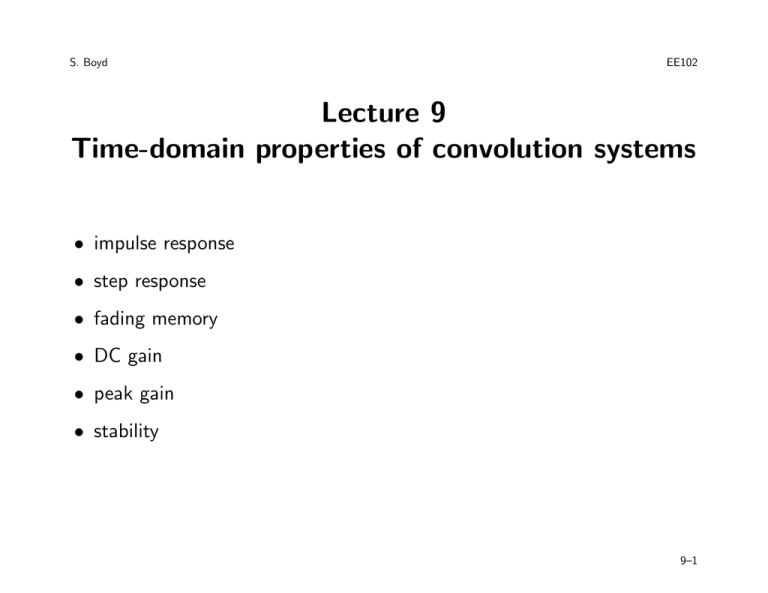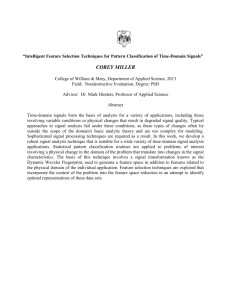Lecture 9 Time-domain properties of convolution systems
advertisement

S. Boyd EE102 Lecture 9 Time-domain properties of convolution systems • impulse response • step response • fading memory • DC gain • peak gain • stability 9–1 Impulse response if u = δ we have y(t) = Z t h(t − τ )u(τ ) dτ = h(t) 0− so h is the output (response) when u = δ (hence the name impulse response) PSfrag replacements H impulse response testing: • apply impulse input and record resulting output (h) • now you can predict output for any input signal • practical problem: linear model often fails for very large input signals Time-domain properties of convolution systems 9–2 Step response the (unit) step response is the output when the input is a unit step: s(t) = Z t h(τ ) dτ 0 (symbol s clashes with frequency variable, but usually this doesn’t cause any harm) relation with impulse response: s(t) is the integral of h, so h(t) = s0(t) step response testing: • apply unit step to input and record output (s) • the impulse response is h(t) = s0(t), so now you can predict output for any input signal • widely used Time-domain properties of convolution systems 9–3 Fading memory we say the convolution system has fading memory if h(τ ) → 0 as τ → ∞ • means current output y(t) depends less and less on u(t − τ ) as τ gets large (i.e., the remote past input) • if h(τ ) = 0 for τ > T , then system has finite memory : y(t) depends only on u(τ ) for t − T ≤ τ ≤ t if H is rational, fading memory means poles of H are in left halfplane (poles in right halfplane or on the imaginary axis give terms in h that don’t decay to zero) Time-domain properties of convolution systems 9–4 DC gain the DC (direct current) or static gain of a convolution system is H(0) = Z ∞ h(τ ) dτ 0 (if finite, i.e., if s = 0 is in ROC of H) in terms of step response: H(0) = lim s(t) t→∞ interpretation: if u is constant, then for large t, y(t) = u Z t h(τ ) dτ ≈ H(0)u 0 so H(0) gives the gain for static (constant) signals Time-domain properties of convolution systems 9–5 Vehicle suspension example transfer function from road to vehicle height (page 7-7): bs + k H(s) = ms2 + bs + k • for m > 0, b > 0, k > 0 poles are in LHP, hence system has fading memory • DC gain: H(0) = 1 (obvious!) step response gives vehicle height after going over unit high curb at t = 0 Time-domain properties of convolution systems 9–6 impulse response and step response for k = 1, b = 0.5, m = 1 1.6 1 1.4 1.2 0.5 h(t) s(t) 1 replacements 0.8 0.6 0 PSfrag replacements 0.4 0.2 s(t) −0.5 0 h(t) 5 10 15 20 0 0 t 5 10 15 20 t • poles are −0.25 ± j 0.97 (underdamped) • step response ‘overshoots’ about 50%; settles at one in about 20sec Time-domain properties of convolution systems 9–7 impulse response and step response for k = 1, b = 2, m = 1 1.4 2 1.2 1.5 1 s(t) h(t) 1 0.8 PSfrag replacements 0.4 0.5 replacements 0 s(t) −0.5 0 0.6 0.2 5 10 15 20 h(t) t 0 0 5 10 15 20 t • repeated pole at −1 (critical damping) • about 15% overshoot; step response settles in about 5sec Time-domain properties of convolution systems 9–8 Example PSfrag replacements wire modeled as 3 RC segments: 1Ω vin 1Ω 1F 1F 1Ω vout 1F (except for values, could model interconnect wire in IC) (after alot of algebra) we find 1 H(s) = 3 s + 5s2 + 6s + 1 • poles are −3.247, −1.555, −0.198 • DC gain is H(0) = 1 (again, obvious) Time-domain properties of convolution systems 9–9 step response gives vout when vin is unit step (as in 0 → 1 logic transition) 0.15 1 0.8 h(t) s(t) 0.1 replacements 0.6 0.4 0.05 PSfrag replacements 0.2 s(t) 0 0 5 10 15 20 25 30 h(t) t 0 0 5 10 15 20 25 30 t wire delays transition about 20sec or so Time-domain properties of convolution systems 9–10 (Peak) gain y(t) = Z t h(τ )u(t − τ ) dτ 0 the peak values of the input & output signals as peak(y) = max |y(t)|, t≥0 peak(u) = max |u(t)| t≥0 peak(y) be? question: how large can peak(u) answer is given by the peak gain of the system, defined as peak(y) = α = max u6=0 peak(u) Z ∞ |h(τ )| dτ 0 i.e., for any signal u we have peak(y) ≤ α peak(u) and there are signals where equality holds Time-domain properties of convolution systems 9–11 for any t we have ¯ ¯Z t ¯ ¯ ¯ |y(t)| = ¯ h(τ )u(t − τ ) dτ ¯¯ 0 Z t |h(τ )| |u(t − τ )| dτ ≤ 0 ≤ peak(u) Z ≤ peak(u) Z t |h(τ )| dτ 0 ∞ |h(τ )| dτ 0 which shows that peak(y) ≤ α peak(u) Time-domain properties of convolution systems 9–12 conversely, we can find an input signal with Z ∞ peak(y) ≈ |h(τ )| dτ peak(u) 0 choose T large and define u(t) = ½ sign(h(T − t)) t ≤ T 0 t>T then peak(u) = 1 and y(T ) = Z T h(τ )sign(h(τ )) dτ = 0 Z T |h(τ )| dτ, 0 for large T this signal satisfies peak(y) ≈ peak(u) Time-domain properties of convolution systems Z ∞ |h(τ )| dτ 0 9–13 example: H(s) = 1/(s + 1), so h(t) = e−t • DC gain is one, i.e., constant signals are amplified by one Z ∞ |e−t| dτ = 1 which is the same as the DC gain • peak gain is 0 so for this system, peak of the output is no more than the peak of the input more generally, • peak gain always at least as big as DC gain since Z ∞ 0 ¯Z ¯ |h(τ )| dτ ≥ ¯¯ ∞ 0 ¯ ¯ h(τ ) dτ ¯¯ = |H(0)| • they are equal only when impulse response is always nonnegative (or nonpositive), i.e., step response is monotonic Time-domain properties of convolution systems 9–14 Stability a system is stable if its peak gain is finite interpretation: bounded inputs give bounded outputs peak(y) ≤ α peak(u) also called bounded-input bounded-output stability (to distinguish from other definitions of stability) if H is rational, stability means poles of H are in left halfplane Time-domain properties of convolution systems 9–15


